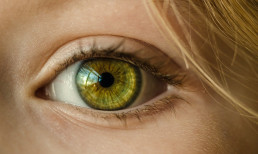For any employee who works in a dangerous workplace environment, wearing safety spectacles is an essential part of their everyday routine. After all, a person’s eyesight is hugely important and needs to be protected no matter what. But why are our eyes so sensitive and how does eyesight work? In this blog article, we explain the structure of the eye and how it works.
Structure of the human eye
The eye is divided into three areas:
The visible part of the eye
All the parts of the eye that we can see at first glance are located here. The circular black pupil is situated in the centre of the eye, surrounded by the coloured iris, which is in turn surrounded by the protective sclera – also referred to as the white of the eye. Injuries can occur to the visible part of the eye when carrying out welding work or working with materials that produce splinters. In the event of superficial burns or small dust particles getting in the eye, any pain and sight impairment will usually only last for a short period of time. However, if an object or flame penetrates the anterior segment of the eye, this can lead to more serious injuries. You should therefore wear the right eye protection according to the type of hazard you are exposed to.

The anterior segment of the eye
The transparent cornea extends across the pupil and iris like a dome, starting from the point where the robust sclera finishes. The conjunctiva is a transparent mucous membrane that covers the entire anterior segment of the eye and ensures that the surface of the eye is kept moist with tears at all times. The conjunctiva also helps our eyes to move smoothly. The ciliary body acts like a tension cable between the lens and iris and holds the lens in place. The posterior segment of the eye is located behind the lens.
The posterior segment of the eye
If the posterior segment of the eye is injured, this can affect our overall power of vision and result in permanent damage because this is where sensitive nerves that are responsible for vision are located.
The vitreous body is located immediately behind the lens, which fills the entire eyeball. The gel-like vitreous body consists of over 90% water and helps to stabilise the shape of the eye, which is spherical and around 22 millimetres in diameter. The retina runs across the vitreous body, along the posterior segment of the eye. The retina consists of ten layers and is around 0.1 – 0.5 mm thick. The macula forms part of the structure of the retina, which is also referred to as the “yellow spot” due to its yellow-coloured pigments. The retina is followed by the choroid, which lies directly beneath the iris. The choroid supplies the eye with oxygen and nutrients. The optic nerve is located right at the back of the eye and plays a key role in our ability to see.

How does eyesight work?
Now we know about the structure of the human eye, we can turn our attention to how the eye works – because once we understand how vision works and how complex the eye is, we will know to appreciate and protect our eyesight more.
Every one of the components mentioned above is important and plays a key role in the visual process or helps to protect the eye.
Once we have identified an object we want to see, we start by moving the eyeball into the correct position in order to be able to register the object in the centre of our field of vision. The cornea and lens then capture the image and send it to the macula. The individual layers of the retina each consist of rods and cones. The rods are responsible for perception of light and dark and the cones for identifying colours. Since the macula consists of a particularly large number of cones, the yellow spot has the most acute vision of the captured images. Photoreceptors are also located in the retina, which convert the captured light into electrical signals. In a final step, these electrical signals are transmitted to the brain via the optic nerve, where the stimuli received are pieced together to produce a complete image.
Our lens uses accommodation to allow us to perceive images clearly. In this process, the lens is adjusted according to distance in order to regulate the sharpness of the image. The way our lenses work is comparable to the focus of a camera, where the lens aims at a target and focuses accordingly in order to take a clear photo. The high refractive power of the cornea also provides us with sharp vision.
The iris acts like a “sun visor” to protect our eyes from the sun or artificial light – as soon as too much light shines onto our eye, the iris contracts to protect the pupil from the light beam. However, this protection is often not enough, which is why it is vital that you wear the right eye protection with an appropriate sun protection factor. We will be happy to advise you on the right lens tint for your work environment.